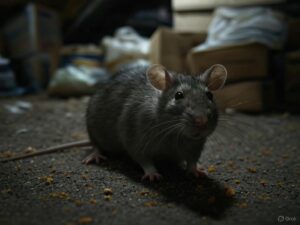Protect Your Home from Rat Infestations: Expert Rat Control Services
Rats aren’t just a nuisance; they’re a serious threat to your home and health. In Quincy, IL and surrounding areas, homeowners face the challenge of dealing with two primary types of rat infestations: Norway rats and roof rats. This page will provide you with essential information about these pests and how Double G Pest Control can help you eliminate and prevent rat problems.

Understanding the Threat: Norway Rats vs. Roof Rats
Effective rat control starts with understanding your enemy. While both Norway and roof rats are rodents that can cause significant damage, they have distinct characteristics and habits:
Norway Rats (Rattus norvegicus)
- Appearance: Larger and more robust than roof rats, Norway rats have brown fur with a lighter underside. They have blunt noses and relatively small ears. Their tails are shorter than their body length.
- Habitat: Also known as “brown rats” or “sewer rats,” Norway rats are burrowers. They prefer to live at ground level, often nesting in burrows under buildings, in foundations, or near garbage areas. They can also be found in basements, crawl spaces, and cluttered areas.
- Behavior: Norway rats are strong swimmers and are often found near water sources. They are opportunistic feeders, consuming a wide variety of food sources, including garbage, pet food, and stored grains.
- Key identifiers: Brown fur, blunt nose, shorter tail, ground burrows.

Roof Rats (Rattus rattus)
- Appearance: Sleeker and more agile than Norway rats, roof rats have black or dark brown fur. They have pointed noses, large ears, and long, slender tails that are longer than their body length.
- Habitat: Also known as “black rats,” roof rats are excellent climbers. As their name suggests, they prefer to nest in higher locations, such as attics, roofs, trees, and wall voids.
- Behavior: Roof rats are agile and can easily access buildings through small openings in roofs, eaves, and vents. They are more likely to feed on fruits, nuts, and vegetables, but they will also consume other food sources when available.
- Key identifiers: Dark fur, pointed nose, long tail, attic/roof nesting.
The Dangers of Rat Infestations
Regardless of the species, a rat infestation poses significant risks:
- Disease Transmission: Rats carry and transmit various diseases, including leptospirosis, hantavirus, salmonellosis, and rat-bite fever. Their droppings, urine, and saliva contaminate surfaces and food, posing a serious health hazard.
- Property Damage: Rats have powerful teeth and constantly gnaw to keep them worn down. They can chew through electrical wiring (creating a fire hazard), wood, plastic, and even some metals, causing significant structural damage.
- Contamination: Rat droppings and urine contaminate food storage areas, leading to food spoilage and potential illness.
- Breeding: Rats are known to breed quickly.
- Reputation Damage (for Businesses): For businesses, especially in the food service industry, a rat sighting can severely damage reputation and lead to costly closures.
Signs of a Rat Infestation
Early detection is crucial for effective rat control. Look out for these warning signs:
- Droppings: Rat droppings are a telltale sign. Norway rat droppings are larger and capsule-shaped, while roof rat droppings are smaller and more curved.
- Gnaw Marks: Look for fresh gnaw marks on wood, plastic, wiring, or food packaging.
- Rub Marks: Rats often travel along the same paths, leaving greasy rub marks along walls and baseboards.
- Noises: Scratching, scurrying, or squeaking sounds, especially at night, can indicate rat activity.
- Nests: Rats build nests from shredded materials like paper, fabric, and insulation.
- Burrows: (Primarily for Norway rats) Look for holes in the ground near building foundations or under debris.
- Tracks: Footprints from rats.
- Unusual Pet Behavior: Pets may become agitated or show unusual interest in specific areas if they detect rats.
Double G Pest Control: Your Rat Control Experts
If you suspect a rat infestation, don’t wait! Professional intervention is essential for effective and lasting rat control. Double G Pest Control offers comprehensive rat control services, including:
- Inspection: We conduct a thorough inspection of your property to identify the type of rat, the extent of the infestation, and entry points.
- Exclusion: We seal entry points to prevent rats from entering your home. This is a critical step in long-term rat control.
- Trapping: We use safe and effective trapping methods to remove existing rats from your property.
- Sanitation Recommendations: We provide advice on eliminating food sources and maintaining a clean environment to discourage future infestations.
- Ongoing Monitoring and Prevention: We offer ongoing pest control plans to prevent future rat problems.
Don’t Let Rats Take Over Your Home!
Contact Double G Pest Control today for a free consultation and take the first step towards a rat-free home. We are your trusted local experts in rat control, providing effective and humane solutions to protect your property and your family’s health.
Call us at 217-440-2847 or fill out our online form to schedule an appointment.

